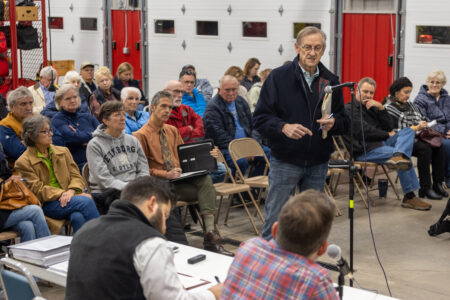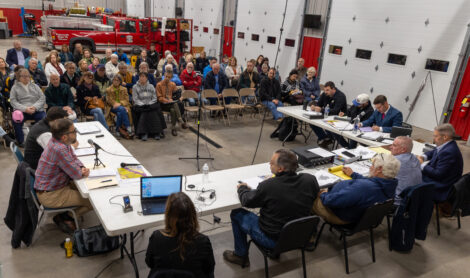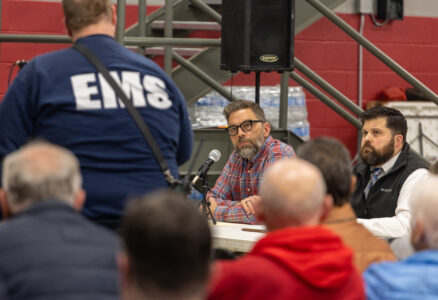Street-smart? Hearing contends with questions about proposal’s impact on traffic
- KAREN VIBERT-KENNEDY/Sun-Gazette Howard Williams asks a question during the conditional use hearing by the Muncy Creek Township supervisors at the Muncy Area Volunteer Fire Company in Muncy on Wednesday.
- KAREN VIBERT-KENNEDY/Sun-Gazette Testimony is heard during a conditional use hearing by the Muncy Creek Township supervisors at the Muncy Area Volunteer Fire Company in Muncy on Wednesday.
- KAREN VIBERT-KENNEDY/Sun-Gazette Rick Henry, senior hydrogeologist, center, listens to a question from John Neiswender, left, during the conditional use hearing by the Muncy Creek Township supervisors at the Muncy Area Volunteer Fire Company in Muncy on Wednesday.
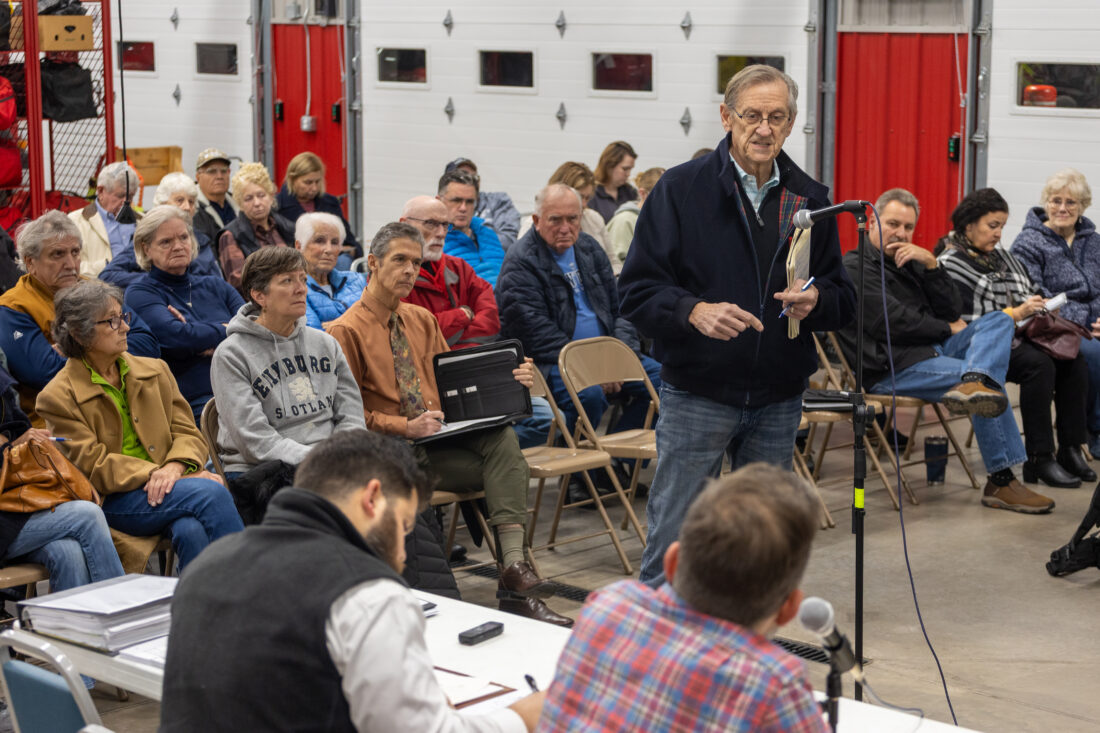
KAREN VIBERT-KENNEDY/Sun-Gazette Howard Williams asks a question during the conditional use hearing by the Muncy Creek Township supervisors at the Muncy Area Volunteer Fire Company in Muncy on Wednesday.
Could heavy trucks traveling to and from a proposed industrial-size chicken farm that would produce eggs near Muncy be a potential safety risk to motorists and pedestrians?
It was one of many questions for the applicant, Sunny Side Up Farms LLC of Lancaster, which seeks conditional use approval before the Muncy Creek Township Board of Supervisors to bring a concentrated animal feeding operation (CAFO) consisting of five barns and 350,000 chickens to land along Clarkstown Road in Muncy Creek Township.
Traffic-related concerns
Gregory Creasy, a traffic specialist with a civil engineering educational background, who works for Grove Miller Engineer, testified on behalf of the opposition.
He answered numerous traffic safety-related questions directed by Attorney Zachary DuGan, and cross-examination questions posed by the applicant’s attorney, Samuel E. Wiser Jr.
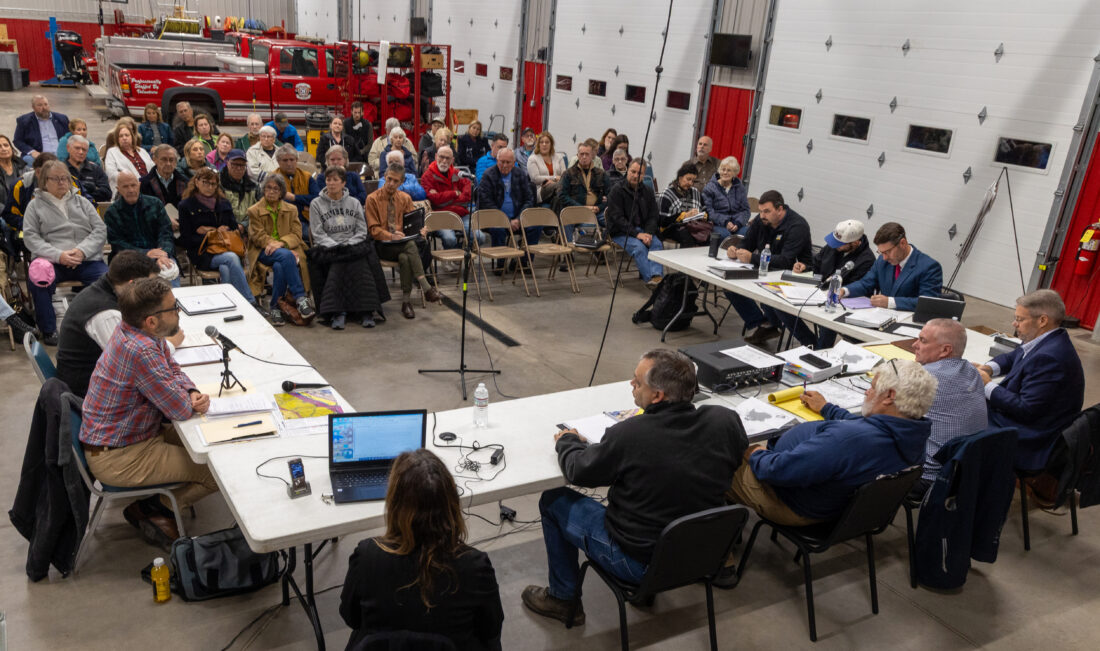
KAREN VIBERT-KENNEDY/Sun-Gazette Testimony is heard during a conditional use hearing by the Muncy Creek Township supervisors at the Muncy Area Volunteer Fire Company in Muncy on Wednesday.
“Has there been sufficient information presented for you to come to the conclusion that there has been a satisfactory provision for the ingress and egress to the CAFO properties on Fogelman and Muncy Exchange roads?” asked DuGan, who has been retained by the Muncy Area Neighborhood Preservation Coalition.
“In my opinion having the site distances information from the proposed driveway locations would be vital to be able to say they are located appropriately,” Creasy said.
Another factor for consideration was the volume of truck traffic. In prior testimony it was established the egg-production farming operation would require an estimate of 1,290 trucks a year, or 2,580 round-trips.
Posted weight on one road was talked about.
Fogelman Road, a township-maintained road on the east side of the site, is posted with a 20-ton weight limit, or 80,000 pounds, meaning a truck that was 80,000 pounds could not legally be on it, Creasy said.
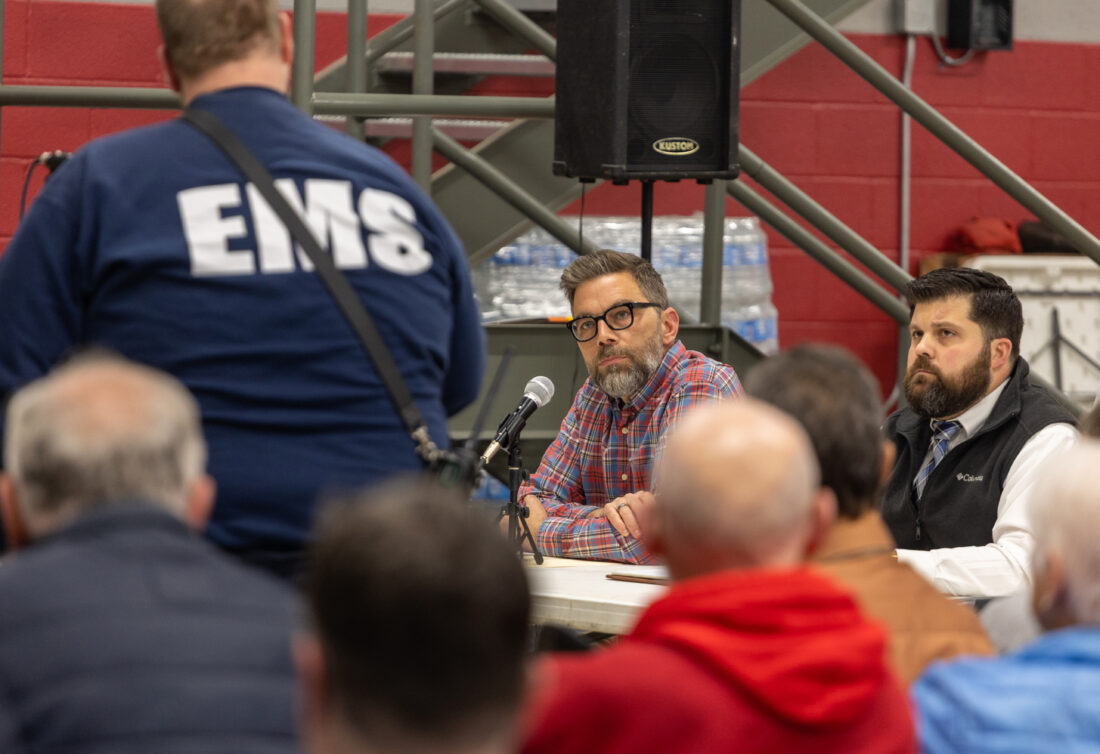
KAREN VIBERT-KENNEDY/Sun-Gazette Rick Henry, senior hydrogeologist, center, listens to a question from John Neiswender, left, during the conditional use hearing by the Muncy Creek Township supervisors at the Muncy Area Volunteer Fire Company in Muncy on Wednesday.
He also expressed concern about the width of the road and curves along parts of it. The road was 22 feet wide in some locations and 20 feet wide in another. DuGan asked him if a truck and school bus were on it — could they pass each other safely? He said his estimation was the road may not have been properly designed to accommodate “heavy trucks.”
In his cross examination of the witness, Wiser asked him about milk trucks, combines and corn pickers, which are already using the road.
Creasy, furthermore, answered DuGan’s direct question on site distance, stressing their importance in determining overall safety factors. As a traffic safety expert, he explained how the speed of the truck or vehicle can increase the potential risk for crashes and near misses.
Muncy Exchange Road, on the west side of the site, which is a state Department of Transportation (PennDOT) road, is wider and has been determined to have better site distance than Fogelman Road. Additionally, Muncy Exchange Road may be a better location to have a driveway accessing the farm, Creasy said.
Creasy further suggested that a traffic-impact study and truck routing plan should be submitted by the applicant.
Wiser asked Creasy if he was aware a Highway Occupancy Permit (HOP) would be required for Muncy Exchange Road to meet (PennDOT) standards and a traffic impact study may be required at the HOP stage.
The caveat with the HOP with Muncy Exchange Road is the impact or study would only be on that road, and not include Fogelman Road. The HOP would be limited to that access point off of Muncy Exchange Road, DuGan said in a follow up.
“It is unclear to us as to whether there has been or is a HOP,” he said, adding, “they may have made an application but the traffic engineer has not been presented with information.”
Manure loads and potential contamination
The hearing continued with testimony by Rick Henry, a senior hydrogeologist with Meiser & Earl Inc., who remained under oath on the stand. His testimony was relevant to the amount of water needed for the birds and CAFO operation, a specific kind of rock formation beneath the site, and calculated manure loads.
The project sponsor’s hydrogeologist provided 17,000 gallons per day, a volume he pulled, Henry said. It seemed quite low to Henry because of the water figure he used derived from the Penn State Extension, representing the 17,000 gallons. But Henry said that is the amount of water needed by the animal, and has nothing to do with the total potential water needs — such as cooling, washing of the facility, etc. Henry said a more realistic estimate was between 30,000 and 45,000 gallons per day — and said he was giving a “range.”
Henry acknowledged, after Wiser’s cross examination, that he did not have “expertise in animal husbandry.”
Henry’s testimony also revisited prior discussions in the hearing about one of the underlying types of rock formation, the Ridgeley Sandstone member of the Old Port formation, which lies beneath a portion of the property. It is a rock formation capable of yielding several hundred gallons of water per minute, and is highly porous, he said.
Henry provided a revised number on expected manure loads for various percentages of the free-range, cage-free chickens excrement of birds that would graze outside of the barns.
He calculated how much manure this facility makes in a day and calculated what percent of that would be excreted outside and provided examples of 5% and 10% of manure load.
In an effort to be more conservative, Henry assumed birds were 4 pounds, or the lower end of the typical chicken’s weight, and he converted the manure to dry weight, not wet, thereby reducing the load by another 40%.
About 5% of the manure would be 29 tons per acre per year, and 10% is 58 tons per acre per year, he said.
He also used an example of matching that amount with the typical application rates growing soybeans or corn crops, which he said were 1 to 10 tons per acre per year.
He said he did this after finding peer-reviewed, industry-approved research accepted by the U.S. Department of Agriculture’s National Resources Conservation Service.
In that, the excretion rate is 60.5 pounds per thousand pounds of animal per day. The NRCS, a division of the USDA, standardized all livestock in that manner. With cattle it’s 59 pounds per thousand pounds of beef cattle per day. Two, 500-pound beef cattle can excrete 59 pounds per day, he explained.
Justin Reis, a real estate broker, testified to facts under the sellers disclosure law, which can affect the marketability of nearby homes. It was considered pertinent testimony because part of the conditional use requirement the applicant must meet is that there would be no adverse impacts to nearby properties based, in this case, on the operation of a CAFO.
Reis was qualified in residential real estate brokerage, and his testimony did include in his opinion as a real estate broker an adjacent CAFO would and should be disclosed on a seller schedule. The surrounding properties could be affected and reduce demand and affect prices, he said. The seller must disclose any known “material defects” that pose a significant impact to the value or unreasonable risk for people on the nearby residential property.
There is no set distance as to who or what would have to disclose.
“If I were advising a client, I’d advise to disclose it being near a CAFO,” Reis said.
When Wiser repeatedly questioned Reis about what specific material defects were in the proposal, Reis could not provide any examples of any materials defects in the proposed plan. His response was limited to the CAFO itself.
Attorney J. Michael Wiley, solicitor for township, lastly asked Reis to clarify for the record that he was a neighbor of the proposed project, which he did.
The next solar conditional use hearing is Dec. 8 at 7 p.m. at the township building, 575 Route 442, and the next CAFO-related hearing will be 7 p.m. on Dec. 17 at the Muncy Area Volunteer Fire Co. The proposal is considered to be agrivoltaic with aspects of agriculture and farming and energy generation.

